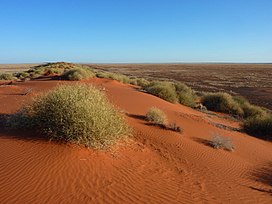| Simpson Desert | |
|---|---|
| Munga-Thirri | |
 Dunes at the edge of the Simpson Desert | |
 The IBRA boundaries of the Simpson Desert | |
| Area | 176,500 km2 (68,100 sq mi) |
| Geography | |
| Country | Australia |
| States |
|
| Coordinates | 24°34′S 137°25′E / 24.57°S 137.42°E |
The Simpson Desert is a large area of dry, red sandy plain and dunes in the Northern Territory, South Australia and Queensland in central Australia.[1][2] It is the fourth-largest Australian desert, with an area of 176,500 km2 (68,100 sq mi).
The Wangkangurru Yarluyandi people know this area as Munga-Thirri.[3]
The desert is underlain by the Great Artesian Basin, one of the largest inland drainage areas in the world. Water from the basin rises to the surface at numerous natural springs, including Dalhousie Springs, and at bores drilled along stock routes, or during petroleum exploration. As a result of exploitation by such bores, the flow of water to springs has been steadily decreasing in recent years. It is also part of the Lake Eyre basin.
The Simpson Desert is an erg that contains the world's longest parallel sand dunes.[4] These north-south oriented dunes are static, held in position by vegetation. They vary in height from 3 m (9.8 ft) in the west to around 30 m (98 ft) on the eastern side. The largest dune, Nappanerica or Big Red, is 40 m (130 ft) in height.[5]
- ^ Twidale, C.R. (1980). "The Simpson Desert, central Australia". South African Geographical Journal. 65: 3–17. doi:10.1080/03736245.1980.10559618.
- ^ "Desert Parks of South Australia" (PDF). Department of Environment and Heritage, South Australia. Archived from the original (PDF) on 29 July 2008. Retrieved 23 October 2008.
- "Simpson Desert". Britannica Encyclopedia Inc. Retrieved 23 October 2008.
- ^ "Munga-Thirri–Simpson Desert National Park- Draft Management Plan 2021" (PDF). Government of South Australia. 2021. p. 2.
- ^ Madigan, C.T. 1936. The Australian sand-ridge deserts. The Geographical Review 26(2):205-227.
- ^ Rachel Dixon (2018). Deserts & Savannahs in Australia. Redback Publishing. p. 23. ISBN 9781925630206.